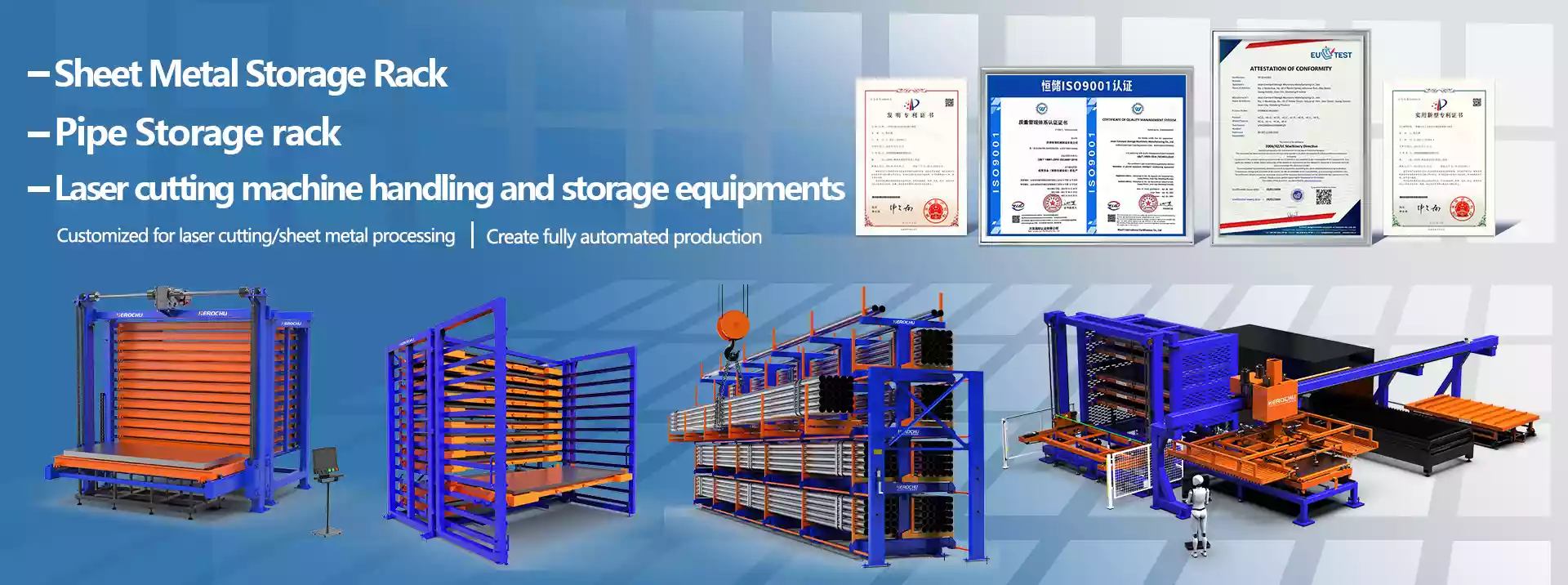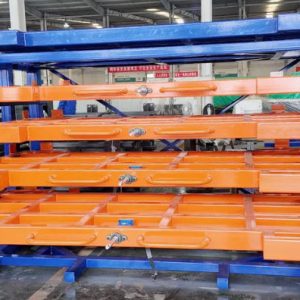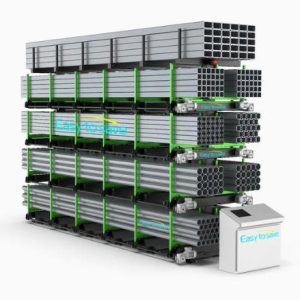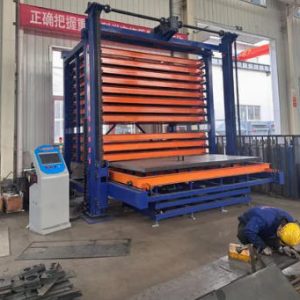Herochu Sheet Metal Rack Safety Rules: Essential OSHA Checklist for Warehouse Operations
Every warehouse or fabrication shop knows this truth: sheet metal storage isn’t just about organization—it’s about keeping people safe. A single misstep with a heavy steel or aluminum sheet can lead to broken bones, equipment damage, or even worse. That’s why Herochu’s sheet metal racks are engineered to turn high-risk, multi-person chaos into standardized, low-risk, one-person operations. But a safe rack is only as effective as the rules you follow to use it.
This guide isn’t just a list of “do’s and don’ts”—it’s an OSHA-aligned safety checklist tailored to Herochu’s CE, UE, and ISO 9001 certified sheet metal racks. Whether you’re using hand-pull drawers for light loads, hand-crank models for heavier sheets, or forklift-ready racks for industrial-grade weight, these rules will protect your team, your materials, and your bottom line. And since Herochu racks are customizable to your workshop (starting at $4,399), we’ll also show you how to align these safety practices with your unique setup—because no two warehouses operate the same way.
The Why Behind the Rules: Safety Isn’t Just Compliance—it’s Profit Before diving into the checklist, let’s get one thing clear: sheet metal rack safety isn’t just about avoiding OSHA fines (though those can reach $136,532 for serious violations). It’s about protecting the most valuable asset in your warehouse: your people. A single injury can lead to weeks of lost productivity, workers’ compensation claims, and a damaged team culture.
But safety also boosts your bottom line. Herochu’s racks are designed to eliminate “digging” through floor stacks—a process that wastes 2+ hours per day per machine, damages 50–200 sheets of metal, and clogs up 70% of your floor space. When you follow these safety rules, you’re not just keeping people safe—you’re ensuring your rack operates at peak efficiency. No more downtime from accidents, no more scrap from mishandled materials, and no more wasted time from disorganized, risky workflows.

Safety and productivity go hand in hand. These rules aren’t just hoops to jump through—they’re the blueprint for a smoother, more profitable warehouse.
Core Safety Operations: Tailored to Your Herochu Rack Type
Herochu offers three main rack types, each engineered for specific loads and workflows. The safety rules for each are different—because a hand-pull drawer for 1,200 lb aluminum sheets needs a different approach than a forklift-ready rack for 4,500 lb steel plates. Below is your step-by-step guide for each.
1. Pre-Operation Check: The Non-Negotiable First Step (Applies to All Racks)
Before touching any rack—whether it’s 8 AM or 2 PM—you must do a 60-second visual inspection. This single step prevents 80% of rack-related incidents. Here’s what to look for:
- Load Capacity Label: Every Herochu rack has a clearly posted label with the maximum load per drawer (typically 1,500 kg/3,300 lbs to 4,500 kg/9,900 lbs). Confirm the sheets you’re storing today don’t exceed this. Overloading is the #1 cause of rack failure—Herochu racks are built with high-strength Q235 carbon steel, but even the strongest metal bends if pushed beyond its limits.
- Frame and Welds: Check for bent frames, cracked welds, or rust. Herochu’s precision welding is designed to last 10+ years, but accidental impacts (e.g., a forklift nudge) can weaken joints. If you see any damage, lock the rack with a tag and report it to your supervisor—do not use it.
- Rollers and Tracks: For hand-pull and hand-crank racks, ensure rollers are free of dirt, debris, or metal shavings. A jammed roller can cause the drawer to stick, leading to forced pulls (and muscle strains) or sudden slips.
- Floor Space: Clear the area in front of the rack of all tools, pallets, or personnel. You need at least 3 feet of open space to operate the drawer safely—no exceptions.
Skip this check, and you’re rolling the dice. Do it, and you set the stage for a safe shift.
2. Safety Rules for Hand-Pull Drawers (Loads < 1,500 kg / 3,300 lbs)
Herochu’s hand-pull drawers are perfect for lighter materials—think thin aluminum sheets for automotive parts or small steel panels. They’re designed for speed, but speed doesn’t mean cutting corners. Follow these rules:
Operation Steps:
- Clear the Zone: Before pulling, shout a quick “Clear!” to alert nearby teammates. Even if you think no one’s around, warehouse noise can mask someone walking up behind you.
- Pull Smoothly: Grip the drawer handle with both hands (one on each side, if possible) and pull evenly. Herochu’s rollers are designed for smooth movement—if it feels stuck, stop.
- Secure the Drawer: Once extended, engage the built-in lock (all Herochu hand-pull drawers have one) to prevent it from sliding back while you retrieve materials.
Safety Don’ts:
- Don’t Yank or Jerk: A stuck drawer isn’t a sign to pull harder—it’s a sign to check for debris in the tracks. Forcing it can bend the drawer or cause the rollers to snap.
- Don’t Overreach: If the sheet is too far back in the drawer, use a material hook (provided with all Herochu racks) to pull it forward. Never climb on the rack or lean over the drawer—you could lose your balance.
- Don’t Leave It Open: Once you’ve retrieved the sheet, push the drawer closed immediately. An open drawer is a tripping hazard for teammates and a target for accidental impacts from forklifts.
3. Safety Rules for Hand-Crank Drawers (Loads 1,500 kg – 3,000 kg / 3,300 lbs – 6,600 lbs)
Herochu’s hand-crank drawers are game-changers for heavier loads. The gear mechanism lets one person move 3,000 lbs with minimal effort—eliminating the need for two people to lift (and the risk of strained backs). But the gear system only works safely if you use it correctly:
Operation Steps:
- Attach the Crank Securely: The crank handle locks into place—twist it until you hear a “click” to confirm it’s connected. A loose crank can fly off mid-operation, causing injuries.
- Crank Steadily: Turn the handle at a slow, even pace (1–2 rotations per second). Herochu’s gears are designed to do the work—there’s no need to rush.
- Use the Brake: When the drawer is fully extended, engage the brake (a small lever on the side of the crank) to hold it in place. This prevents the drawer from sliding back if someone bumps it.
Safety Don’ts:
- Don’t “Help” the Crank: Resist the urge to pull on the drawer while cranking. The gear system is calibrated to handle the load—adding extra force can strip the gears or cause the drawer to jerk forward.
- Don’t Let Untrained Staff Operate It: Only team members who’ve been trained on the crank mechanism should use it. The gear system is simple, but misuse can lead to serious damage.
- Don’t Skip Lubrication: Herochu recommends lubricating the gear system every 3 months (or after 100 uses, whichever comes first). Use the lithium-based lubricant provided with the rack—dry gears grind, overheat, and fail.
4. Safety Rules for Forklift-Ready Racks (Loads up to 4,500 kg+ / 9,900 lbs+)
For the heaviest materials—think thick steel plates for construction or industrial machinery—Herochu’s forklift-ready racks are the safest option. They eliminate manual handling entirely, but forklift operations come with their own risks. Follow these rules to keep everyone safe:
Operation Steps:
- Verify Forklift Capacity: The forklift’s maximum load must exceed the fully loaded weight of the drawer. For example, if the drawer holds 4,500 lbs of steel, use a forklift rated for 5,000 lbs or more.
- Align Forks Perfectly: Herochu racks have integrated fork pockets—line the forklift’s forks up with these pockets exactly. If the forks are off-center, the drawer can tip when lifted.
- Lift Smoothly: Raise the forks slowly, then tilt the mast back slightly (5–10 degrees) to keep the drawer stable. Never lift the drawer higher than needed—12–18 inches off the rack is enough to move it.

Safety Don’ts:
- Don’t Use an Untrained Forklift Operator: Only certified operators should handle forklift-ready racks. OSHA reports that 70% of forklift accidents involve untrained operators—don’t let this happen in your warehouse.
- Don’t Rush the Return: When putting the drawer back, lower it slowly and ensure it’s fully seated in the rack frame before pulling the forks out. A drawer that’s not seated properly can slide out later, causing a collapse.
- Don’t Allow Pedestrians Nearby: Create a 10-foot “no-go” zone around the rack during forklift operations. Use cones or barriers to keep teammates back—even a small mistake can lead to a catastrophic accident.
The “Golden Rules” of Sheet Metal Rack Safety: The Non-Negotiables
No matter which Herochu rack you use, these five rules are absolute. Break them, and you’re putting your team at risk. Follow them, and you’ll create a culture of safety that lasts.
Rule 1: NEVER Open More Than One Drawer at a Time
This is the most important rule in this guide. Herochu racks are balanced to handle one open drawer at a time—opening two or more shifts the center of gravity, leading to the rack tipping over. Even if you think you’re “just grabbing a quick sheet,” opening a second drawer is a death sentence for safety. One drawer open at a time—always.
Rule 2: NEVER Overload a Drawer
We’ve said it before, but it’s worth repeating: overloading is the #1 cause of rack failure. Herochu’s Q235 steel is strong, but it has limits. If you’re not sure if your sheets exceed the load capacity, weigh them—invest in a portable scale if you need to. A
50scaleischeaperthana10,000 injury claim.
Rule 3: NEVER Stand, Climb, or Ride on Any Part of the Rack
Herochu racks are designed to hold materials, not people. Climbing on the rack to reach a high drawer can cause it to collapse. Standing on an extended drawer can bend the frame or snap the rollers. Even sitting on the rack during a break is risky—one slip, and you’re falling. The rack is for metal, not people.
Rule 4: NEVER Operate a Damaged Rack
If you see a bent frame, cracked weld, or worn roller, lock the rack with a “Do Not Use” tag and report it immediately. A “small” crack can turn into a major failure when you load it with 3,000 lbs of steel. Herochu offers 24/7 repair support for certified racks—don’t wait to fix it.
Rule 5: NEVER Leave a Drawer Extended and Unattended
An open drawer is an accident waiting to happen. A teammate could trip over it, a forklift could hit it, or a gust of wind (from warehouse fans) could push it closed suddenly. Always close the drawer as soon as you’re done with it. If you need to step away mid-task, close the drawer first—no exceptions.

Safe Integration with Lifting Equipment: How to Retrieve Materials Without Risk
Even the safest rack won’t protect you if you mishandle the sheet metal itself. Herochu’s racks are designed with 100% drawer extension—meaning the entire drawer rolls out, so you can reach every sheet without leaning or stretching. But you still need to use the right lifting equipment:
- Vacuum Lifters: For aluminum sheets (which are smooth and non-porous), use a vacuum lifter with a rated capacity higher than the sheet’s weight. Herochu recommends models with dual vacuum pumps—if one fails, the other keeps the sheet secure.
- Sheet Lifters (Magnets): For steel sheets, use a magnetic sheet lifter. Ensure the magnet is fully engaged before lifting—test it by lifting the sheet 1–2 inches off the drawer, then lowering it, before lifting higher.
- Forklift Attachments: For extra-large sheets, use a forklift with a sheet clamp attachment. The clamp should grip the sheet evenly—too tight, and you’ll dent the metal; too loose, and it will slip.
Always train your team on how to use these tools. A vacuum lifter that’s not attached properly can drop a sheet, and a magnetic lifter that’s not engaged can let a steel plate slide—both lead to injuries.
Maintenance: Keep Your Herochu Rack Safe for Years
A safe rack is a well-maintained rack. Herochu’s racks are built to last, but regular maintenance ensures they stay safe and efficient. Here’s your monthly maintenance checklist:
- Inspect Welds: Check all frame welds for cracks, rust, or signs of stress. Use a flashlight to get a clear view—small cracks can be hard to see in dim light.
- Clean Rollers and Tracks: Use a wire brush to remove dirt, metal shavings, or debris from the rollers and tracks. A clean system moves smoothly, reducing the risk of jams.
- Lubricate Moving Parts: For hand-crank racks, lubricate the gears with Herochu’s recommended lithium grease. For hand-pull racks, lubricate the rollers with a light machine oil.
- Test Locks and Brakes: Engage and disengage the drawer locks (hand-pull) and brakes (hand-crank) to ensure they work properly. If a lock is loose, tighten it with a wrench—don’t use it until it’s secure.
- Update Load Labels: If you change the type of material you’re storing (e.g., switching from aluminum to steel), update the load label to reflect the new weight. Outdated labels lead to overloading.
Set a calendar reminder for the first day of each month to do this checklist. It takes 15 minutes, and it prevents costly, dangerous failures.
Why Herochu Racks Make Safety Easier (And More Affordable)
You could buy a generic sheet metal rack and try to cobble together safety rules—but Herochu’s CE, UE, and ISO 9001 certified racks are designed with safety in mind from the start. Here’s how we make your job easier:
- Customizable to Your Workshop: Whether you need a 3-drawer rack for a small fabrication shop or a 10-drawer forklift-ready system for a large warehouse, we build it to fit your space. No more forcing a one-size-fits-all rack into your workflow.
- Built-in Safety Features: Every Herochu rack comes with drawer locks, load labels, integrated fork pockets, and gear mechanisms—no extra purchases needed. We’ve thought of the safety details so you don’t have to.
- Affordable Starting Price: At $4,399, Herochu racks are priced for small and medium businesses. You don’t have to choose between safety and budget—we give you both.
- 24/7 Support: If you have a question about safety rules or need a repair, our team is available around the clock. We don’t just sell you a rack—we partner with you to keep your warehouse safe.
Final Note: Safety Is a Team Effort
These rules work only if everyone on your team follows them. Hold regular safety meetings to review this checklist, train new hires on rack operation, and encourage teammates to speak up if they see a safety violation. A culture of safety isn’t built by one person—it’s built by everyone.
Herochu’s sheet metal racks are the foundation of a safe warehouse, but these rules are the blueprint. Follow them, and you’ll reduce injuries, cut down on scrap, and keep your team happy and productive.
Ready to invest in a safe, customizable sheet metal rack? Contact Herochu today. We’ll help you design a system that fits your workshop, your budget, and your safety goals—because your team deserves the best protection possible.
















